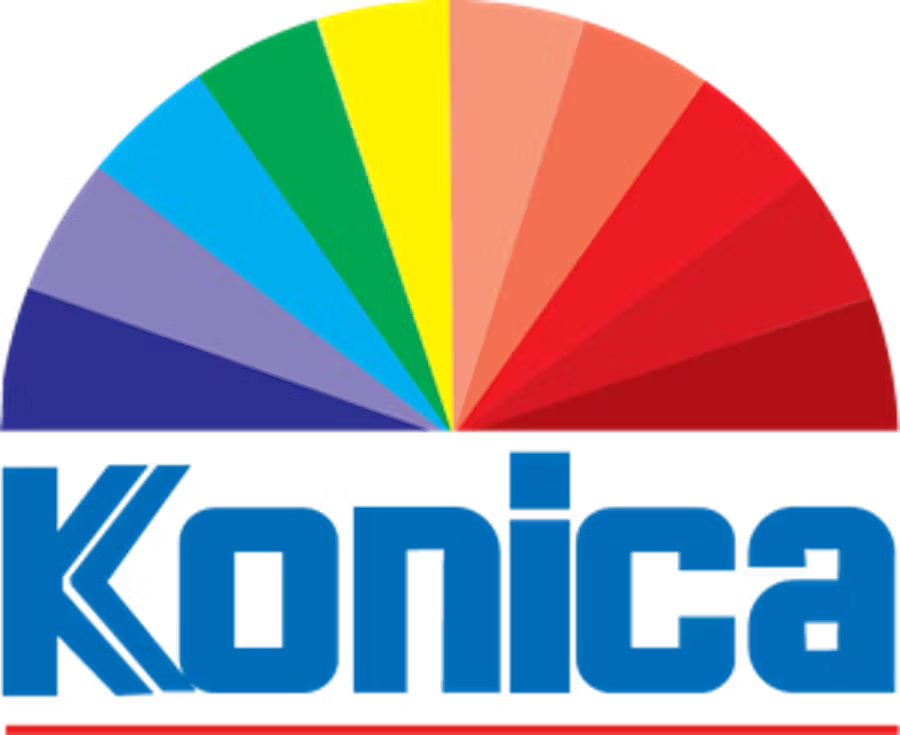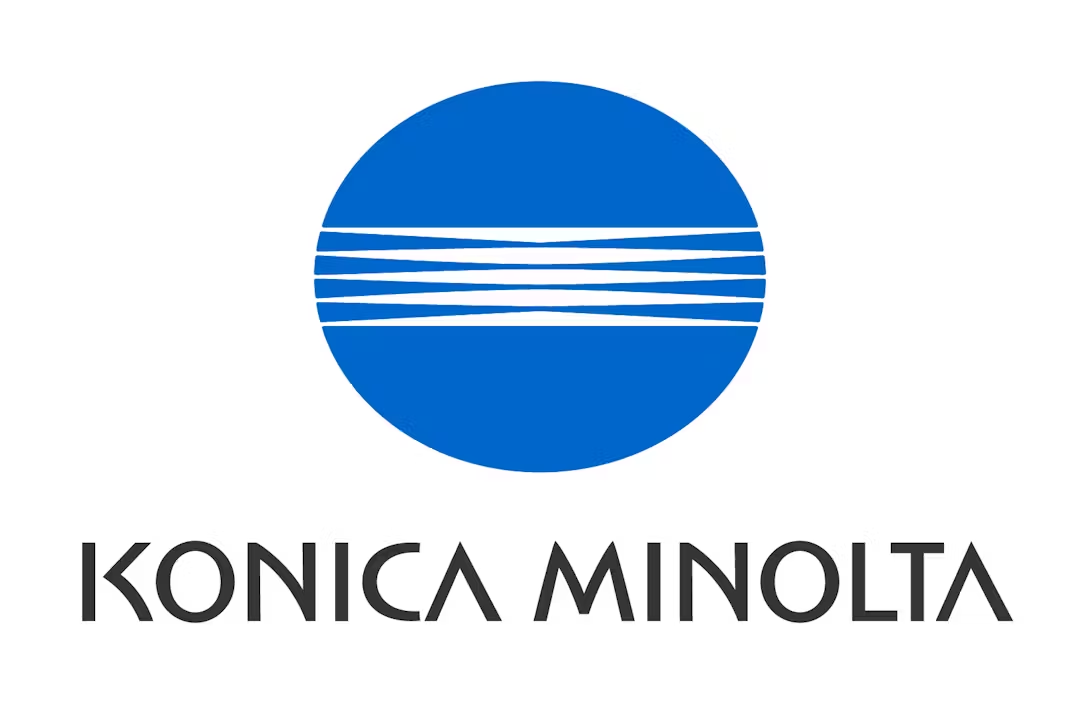Company history
Konica Minolta had its beginnings in the 19th century – and ever since, has been synonymous with quality, innovation and leadership.
The company we know today as Konica Minolta started as two separate businesses – Konica and Minolta – that merged in 2003.

In 1873, a Japanese man named Rokusaburo Sugiura began selling photographic materials at his Tokyo apothecary – Konica.
By the beginning of the 20th century, the company had developed its first camera and a range of quality photographic products. In 1971, Konica released Japan’s first plain paper photocopier, developing a dominant position in high speed, high quality document management systems and imaging products.

Minolta was founded in 1928 to manufacture cameras and then to pioneer related technologies.
This included a latent image transfer system, the world’s first magnification and reduction photocopier, and the world’s first photocopier to produce two-colour images in a single pass. Minolta went on to achieve a strong global presence as a pioneer in the field of high quality imaging technology.

In 2003, both companies came together – and became a technology force to be reckoned with. The early, pioneering spirit in both companies lives on today – and is reflected by our research and development division, which continually reaches into new areas of knowledge.
Today, Konica Minolta is expert in 12 core technologies – including materials, optics, nano-fabrication and imaging. It is this passion for excellence in new technologies that ensures we continue to be a world-leader in research.
Konica Minolta’s history
(1873 – 1956)
Contribution to the Development of Photography (1873 – 1956)

Expansion into Digital and Network Technology (2003 – present)
2022
AeroDR TX m01, a mobile X-ray system that enables X-ray dynamic radiography at the bedside, marketed
2020
AccurioPress C14000, a digital printing system, marketed to enter the high-volume segment.
2019
Konica Minolta Listed among 2019 Global 100 Most Sustainable Corporations in the World.
2018
Konica Minolta Listed among 2019 Global 100 Most Sustainable Corporations in the World.
Konica Minolta partners with Mobile Industrial Robots (MiR) in Australia.
2017
AccurioJet KM-1 officially launched in Australia at PacPrint.
Konica Minolta receives Anti-Slavery Australia Freedom Award.
Konica Minolta named industry group Leader on the Dow Jones Sustainability World Index.
2016
Recognised as World Leader for Corporate Action on Climate Change.
AccurioJet KM-1, a B2 digital inkjet press that achieves excellent image quality comparable to offset printing, is marketed
2015
Konica Minolta Australia enters 3D printing through a partnership with 3D Systems.
Konica Minolta Australia acquires two leading IT Services firms, Stonebridge Systems and Knowledge Partners.
Awarded first place for environmental activities in Japanese Nikkei Environmental Management Survey.
Achieves international recognition among the world’s best companies for corporate social responsibility from RobecoSAM, Oekom Research AG and FTSE4Group.
2014
WeOptimise Cloud Platform launched in Australia.
First Business Innovation Centre (BIC) established in Singapore.
Named leader in Gartner 2014 Magic Quadrant for Managed Print Services and Content Services.
Inclusion into the Dow Jones Sustainability Index.
Recognised as World Leader for Corporate Action on Climate Change.
2012
Release of a new range of colour MFPs featuring a colour touch panel display.
KM-1 previewed at Drupa, the Company’s first high-speed inkjet press processing formats up to B2 at 1,650 sph.
2011
Release of the world’s first Organic Light Emitting Diode (OLED) lighting panels.
2010
Launch of the bizhub PRESS C8000, a flagship colour digital production printing system with a printing speed of 80 ppm.
2009
Konica Minolta Australia moves to a prestigious new Head Quarters in Sydney’s Macquarie Park, named Konica Minolta House
Eco Vision 2050, a policy for environmental activities from a long-term perspective, is formulated
2007
Withdrawal from the photo and camera business.
Release of the bizhub C550, an advanced colour MFP with network features and a sleek new black and white design.
2006
Release of the high-speed digital colour production system, the bizhub PRO C6500.
CBS SwingVision, a high speed motion-analysis system sponsored by Konica Minolta, is awarded a Sports Emmy Award for Outstanding Innovative Technical Achievement.
2005
Released the world’s first mammography system to use phase contrast technology.
Konica Minolta Honda Team competed in the MotoGP, the world’s premier motorcycle racing event
2004
Introduction of the first bizhub multifunctional printer (MFP), bringing fast document printing, copying and scanning to the hub of any business.
Sunshine Starlight Dome “Manten,” the first planetarium theater directly operated by the manufacturer, opens in Japan
Release of the next-generation textile inkjet printer, the Nassenger V.
Release of the bizhub PRO 1050, a high-performance, on-demand printing machine to meet light production needs.
2003
Konica Corporation and Minolta Co., Ltd are merged to form Konica Minolta Holdings Inc., bringing together the leading technologies and innovations of both companies.

Expansion into Imaging (1975 – 2002)
2002
Release of Simitri toner, the world’s first polymerised toner using biomass technology to reduce environmental impact.
1996
Introduction of the world’s first multifunction machine.
1995
Konica 7050, the world’s fastest digital copier is marketed.
1994
Minolta Camera Co., Ltd. renamed as Minolta Co., Ltd.
Minolta Co., Ltd established in Australia.
1991
Introduction of the world’s first three-colour combination copier and fax.
1990
Release of the CF70, a digital full-colour copier featuring breakthrough LIMOS technology for superior image quality.
1987
Konishiroku Photo Industry Co., Ltd. renamed as Konica Corporation, and all the company’s products offered under the “Konica” brand
Konica Corporation established in Australia.
1985
Release of the world’s first autofocus 35mm SLR camera, the 7000.
1984
Development of an ultra-high precision aspheric plastic lens for CD players.
1983
Release of the world’s first copier with zoom magnification function, the EP450Z.
1980
Kanji Inkjet Printer (Kayser system) developed
Flash photometry type Jaundice Meter, the world’s first product to conduct measurement without drawing blood, marketed
TV ad for the Minolta X-7 featuring Yoshiko Miyazaki causes a sensation
1977
Introduction of the world’s first 35mm compact autofocus camera, the C35AF.
1975
Production of the world’s first copier with latent image transfer.
1971
Release of U-Bix480, a high-performance photostatic plain paper copier.
1962
A specially modified Minolta camera is carried aboard the spacecraft Friendship 7.
In the following decades, Minolta technology is adopted for both Apollo lunar missions and Mir space station missions.
1960
Minolta Copymaster, the Company’s first copier, is released.
1957
The Company’s first Planetarium unit is established.

Contribution to the Development of Photography (1873 – 1956)
1952
Konica Camera Company, Konica’s first U.S. subsidiary, was established in Philadelphia to facilitate distribution of Konica products in the United States.
1940
Introduction of Sakura Natural Colour Film, the first colour film made in Japan.
1936
Konishiroku Honten (later renamed Konica Corporation) established as a joint-stock company through reorganization.
1928
Nichi-Doku Shashinki Shoten (Japan-Germany Photo Company), later Minolta, is established and begins production of cameras in Japan.
1903
The “Cherry Hand Camera” is released to the market, Japan’s first brand name camera.
1873
Konica starts business as Rokusaburo Sugiura begins selling photographic & lithographic materials in Tokyo.
